The History Book Club discussion

This topic is about
What Hath God Wrought
AMERICAN HISTORY
>
WHAT GOD HATH WROUGHT - GLOSSARY ~ (SPOILER THREAD)
date newest »
newest »
 newest »
newest »
message 2:
by
Bentley, Group Founder, Leader, Chief
(last edited Oct 24, 2012 03:52AM)
(new)
-
rated it 5 stars
Harriet Martineau
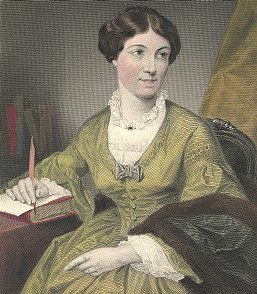
Harriet Martineau was born on June 12, 1802 in Norwich, England to Elizabeth and Thomas Martineau (Conway-Long, 2004; Lengermann & Niebrugge-Brantley, 1998; Simkin, 2001; Willot, 1998). Harriet's parents raised her as a Unitarian, the beliefs of which greatly influenced her life. Although she was sickly and deaf her entire life, she was an amazing women who was greatly ahead of her time and, has been denied the recognition she deserves for her accomplishments and works. She should be one of the "fore-mothers" of sociology.
Harriet was the sixth of eight children (Willett, 1998). The children all received an equal education (well, as much as was possible) until college (Simkin, 2001). Although her parents were quite progressive for their time, when it came time for a higher education, the boys (of course) were sent to continue learning and the girls were not. Being the feminist that she was, Harriet wrote an anonymous article, "On Female Education" for a Unitarian journal, the Monthly Repository, in 1823 (Simkin, 2001). When her brother James found out that she wrote it, he said: "Now, dear, leave it to the other women to make skirts and darn stockings, and you devote yourself to this"(Simkin, 2001)--which is exactly what she did for the rest of her life.
The Unitarian Society, promoting rationalism, individualism, and democracy, formed in the late 18th century as a liberal religious sect that believes that Jesus Christ was a leader who should not be worshipped (Simkin, 2001). Unitarians hold humans responsible for the evil of the world (not an outside force). Therefore, they believe that humans can fix the problems they create (Simkin, 2001). Although Harriet eventually rejected religion (Simkin, 2001), the core characteristics mentioned are prominently displayed throughout her life. Harriet's father arranged a marriage for her, but she refused, focusing instead on more publications for the Monthly Repository. When her father died in 1829, she moved to London and began to receive a little money for her articles in the journal (Simkin, 2001). In 1826, Harriet published two religious books: Devotional Exercises for the Use of Young Persons and Addresses for the Use of Families. She also wrote a book about politics and economics which revealed the influence of the Unitarian belief of social reform, titled Illustrations of Political Economy (1832). That book, in addition to her next one, Poor Laws and Paupers Illustrated (1834) sold so many copies that she earned enough to spend the next two years studying in the United States. Harriet's Unitarian foundation is quite evident in her reports and notes of her visit to the United States, which she published in the book Society in America (1837). What she had noticed was the huge discrepancy between the United States' so-called "democracy" and the actual practices of the society. In the book, she describes a sociological method of studying, noting how important it was to be objective and to observe every possible aspect of behavior to properly form an educated opinion (Conway-Long, 2004; Lengermann & Niebrugge-Brantley, 1998). However, she does not use the term, "sociology," which is coined by Comte or "sociological method," which is attributed to Durkheim-some sixty years later (Conway-Long, 2004). She reports about the treatment of women in the United States during that time in the chapter "The Political Non-existence of Women", and goes so far as to say that an American woman's life equal to that of a slave's, stating "they were both 'given indulgence rather than justice'", (Simkin, 2001, n.p.). Harriet saw that women were denied education and had only one option and duty in the United States: marriage. In her book, she openly writes against discrimination and slavery.
In 1852, Harriet began writing for Charles Dickens' newspaper, the Daily News, where she totaled over 1600 articles (Simkin, 2001). In addition, she wrote for other journals and magazines in support of fair treatment for women in the workforce, for women to be allowed into the medical field, as well as for state education for females. In 1866, she joined other women with a petition for women's suffrage in a presentation to Parliament; and, a few years after Parliament passed the Contagious Diseases Act in 1864, Harriet wrote articles in the Daily News denouncing the law (Simkin, 2001). The Act (justified as an attempt to stop males in the military from catching sexually transmitted diseases) allowed the police to arrest any "prostitutes in ports and army towns" and force them to be tested; and, if they found she had an STD she was imprisoned in a hospital until she was "cured" (Simkin, 2001). The law was sexually discriminatory, as it only applied to females, and was unjust in that the police arrested and imprisoned many females who were not prostitutes. Harriet, along with Josephine Butler and Elizabeth Wolstenholme started the National Association for the Repeal of the Contagious Diseases Act, a campaign in which women spoke to public audiences around the country about and against the Act (Simkin, 2001). Because they were females not afraid to speak about sex in public, the Association created quite a stir but, they continued to fight for over twenty years until Parliament finally repealed the law in 1886 (Simkin, 2001). Unfortunately, Harriet did not live to see that day. She had died ten years earlier but had continued to write and published until her death in 1876 (Conway-Long, 2004; Simkin, 2001).
Harriet Martineau was a strong advocate of women's rights, in a time when women were mostly seen and not heard. She studied different societies, cultures and topics in support of many different subjects and published an amazing amount of literature-despite the fact that she was a female. The world seems to have ignored her studies and ideas. She is mainly remembered only for her translation of Auguste Comte's book on economics (Conway-Long, 2004). Instead, the credit and recognition she deserves has gone widely unacknowledged or unjustly given to men.
(Source: http://www2.webster.edu/~woolflm/mart...)
More:
http://www.brycchancarey.com/abolitio...
http://en.wikipedia.org/wiki/Harriet_...
http://www.spartacus.schoolnet.co.uk/...
http://www25.uua.org/uuhs/duub/articl...
http://www.britannica.com/EBchecked/t...
http://media.pfeiffer.edu/lridener/ds...
http://www.nndb.com/people/976/000049...
http://edocs.lib.sfu.ca/projects/VWWL...
http://www.liberal-international.org/...
http://www.pbs.org/kcet/andrewjackson...
























 all by
all by
 Harriet Martineau
Harriet Martineau

Harriet Martineau was born on June 12, 1802 in Norwich, England to Elizabeth and Thomas Martineau (Conway-Long, 2004; Lengermann & Niebrugge-Brantley, 1998; Simkin, 2001; Willot, 1998). Harriet's parents raised her as a Unitarian, the beliefs of which greatly influenced her life. Although she was sickly and deaf her entire life, she was an amazing women who was greatly ahead of her time and, has been denied the recognition she deserves for her accomplishments and works. She should be one of the "fore-mothers" of sociology.
Harriet was the sixth of eight children (Willett, 1998). The children all received an equal education (well, as much as was possible) until college (Simkin, 2001). Although her parents were quite progressive for their time, when it came time for a higher education, the boys (of course) were sent to continue learning and the girls were not. Being the feminist that she was, Harriet wrote an anonymous article, "On Female Education" for a Unitarian journal, the Monthly Repository, in 1823 (Simkin, 2001). When her brother James found out that she wrote it, he said: "Now, dear, leave it to the other women to make skirts and darn stockings, and you devote yourself to this"(Simkin, 2001)--which is exactly what she did for the rest of her life.
The Unitarian Society, promoting rationalism, individualism, and democracy, formed in the late 18th century as a liberal religious sect that believes that Jesus Christ was a leader who should not be worshipped (Simkin, 2001). Unitarians hold humans responsible for the evil of the world (not an outside force). Therefore, they believe that humans can fix the problems they create (Simkin, 2001). Although Harriet eventually rejected religion (Simkin, 2001), the core characteristics mentioned are prominently displayed throughout her life. Harriet's father arranged a marriage for her, but she refused, focusing instead on more publications for the Monthly Repository. When her father died in 1829, she moved to London and began to receive a little money for her articles in the journal (Simkin, 2001). In 1826, Harriet published two religious books: Devotional Exercises for the Use of Young Persons and Addresses for the Use of Families. She also wrote a book about politics and economics which revealed the influence of the Unitarian belief of social reform, titled Illustrations of Political Economy (1832). That book, in addition to her next one, Poor Laws and Paupers Illustrated (1834) sold so many copies that she earned enough to spend the next two years studying in the United States. Harriet's Unitarian foundation is quite evident in her reports and notes of her visit to the United States, which she published in the book Society in America (1837). What she had noticed was the huge discrepancy between the United States' so-called "democracy" and the actual practices of the society. In the book, she describes a sociological method of studying, noting how important it was to be objective and to observe every possible aspect of behavior to properly form an educated opinion (Conway-Long, 2004; Lengermann & Niebrugge-Brantley, 1998). However, she does not use the term, "sociology," which is coined by Comte or "sociological method," which is attributed to Durkheim-some sixty years later (Conway-Long, 2004). She reports about the treatment of women in the United States during that time in the chapter "The Political Non-existence of Women", and goes so far as to say that an American woman's life equal to that of a slave's, stating "they were both 'given indulgence rather than justice'", (Simkin, 2001, n.p.). Harriet saw that women were denied education and had only one option and duty in the United States: marriage. In her book, she openly writes against discrimination and slavery.
In 1852, Harriet began writing for Charles Dickens' newspaper, the Daily News, where she totaled over 1600 articles (Simkin, 2001). In addition, she wrote for other journals and magazines in support of fair treatment for women in the workforce, for women to be allowed into the medical field, as well as for state education for females. In 1866, she joined other women with a petition for women's suffrage in a presentation to Parliament; and, a few years after Parliament passed the Contagious Diseases Act in 1864, Harriet wrote articles in the Daily News denouncing the law (Simkin, 2001). The Act (justified as an attempt to stop males in the military from catching sexually transmitted diseases) allowed the police to arrest any "prostitutes in ports and army towns" and force them to be tested; and, if they found she had an STD she was imprisoned in a hospital until she was "cured" (Simkin, 2001). The law was sexually discriminatory, as it only applied to females, and was unjust in that the police arrested and imprisoned many females who were not prostitutes. Harriet, along with Josephine Butler and Elizabeth Wolstenholme started the National Association for the Repeal of the Contagious Diseases Act, a campaign in which women spoke to public audiences around the country about and against the Act (Simkin, 2001). Because they were females not afraid to speak about sex in public, the Association created quite a stir but, they continued to fight for over twenty years until Parliament finally repealed the law in 1886 (Simkin, 2001). Unfortunately, Harriet did not live to see that day. She had died ten years earlier but had continued to write and published until her death in 1876 (Conway-Long, 2004; Simkin, 2001).
Harriet Martineau was a strong advocate of women's rights, in a time when women were mostly seen and not heard. She studied different societies, cultures and topics in support of many different subjects and published an amazing amount of literature-despite the fact that she was a female. The world seems to have ignored her studies and ideas. She is mainly remembered only for her translation of Auguste Comte's book on economics (Conway-Long, 2004). Instead, the credit and recognition she deserves has gone widely unacknowledged or unjustly given to men.
(Source: http://www2.webster.edu/~woolflm/mart...)
More:
http://www.brycchancarey.com/abolitio...
http://en.wikipedia.org/wiki/Harriet_...
http://www.spartacus.schoolnet.co.uk/...
http://www25.uua.org/uuhs/duub/articl...
http://www.britannica.com/EBchecked/t...
http://media.pfeiffer.edu/lridener/ds...
http://www.nndb.com/people/976/000049...
http://edocs.lib.sfu.ca/projects/VWWL...
http://www.liberal-international.org/...
http://www.pbs.org/kcet/andrewjackson...
























 all by
all by
 Harriet Martineau
Harriet Martineau
 On page 26 Howe uses Pekka Hämäläinen's "The Rise and Fall of the Plains Indian Horse Culture" as a source - This is a periodical entry from the Journal of American History.
On page 26 Howe uses Pekka Hämäläinen's "The Rise and Fall of the Plains Indian Horse Culture" as a source - This is a periodical entry from the Journal of American History. But Hämäläinen wrote another book published in 2008 by Yale University Press, "The Comanche Empire" (The Lamar Series in Western History). In this very interesting book Hämäläinen lays out the idea that the Comanches had a viable, fearsome and powerful international economic empire which dealt autonomously with the Spanish, French, English and Americans as well as all of its loosely associated tribes.
"For a century, roughly from 1750 to 1850, the Comanches were the dominant people in the Southwest, and they manipulated and exploited the colonial outposts in New Mexico, Texas, Louisiana, and northern Mexico to increase their safety, prosperity, and power. They extracted resources and labor from their Euro-American and Indian neighbors through thievery and tribute and incorporated foreign ethnicities into their ranks as adopted kinspeople, slaves, workers, dependents, and vassals. The Comanche empire was powered by violence, but, like most viable empires, it was first and foremost an economic construction." (p. 2, Kindle Edition).
There are those who say Hämäläinen stretches his point but I'm not so sure.
I've added this to the Glossary page because it's a bit more info than what is included in the book. This Empire was functioning directly within the time frame of which Howe writes, but it's somewhat outside his scope so I am NOT faulting him.
 by
by
 Pekka Hämäläinen
Pekka Hämäläinen
 Visual arts of the era:
Visual arts of the era:I've chosen the graphics because of specific subject matter in What God Hath Wrought, the painter (a variety from the era) and the date given as to the painting's creation. Although born in America, the painters in the first section were trained in England.
From What God Hath Wrought:
The prevailing versions of Protestantism preached a stern morality and self-control. Such austere religion did not foster the traditional high arts of music, painting, and sculpture. (pp. 38-39).
Yes, perhaps the Second Great Awakening had a somewhat negative effect, but the visual arts were developing (if not exactly flourishing) their own distinct American sensibility during this time-frame. One of the few art formal schools was the Philadelphia Academy of Fine Arts which was started in 1805 by Charles Willson Peale who was trained in Britain (and you can tell):
C.W. Peale "The Artist in His Museum" 1822
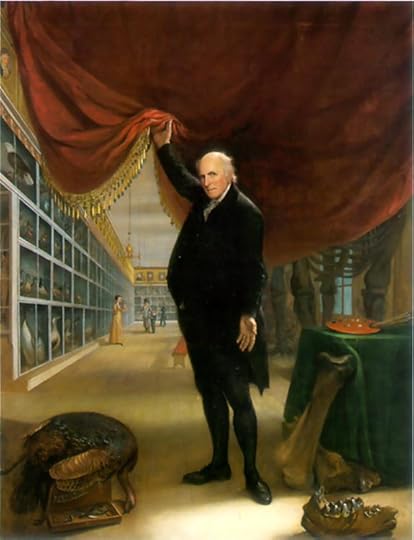
"… when the Capitol was rebuilt, Madison enjoyed the satisfaction of commissioning two huge paintings by John Trumbull depicting British defeats in an earlier war to decorate the walls of the rotunda. 24"
The paintings are The Surrender of General Burgoyne at Saratoga and The Surrender of Lord Cornwallis at Yorktown. (p. 71)
John Trumbull was also trained in England.
Trumbull, "Surrender of General Burgoyne," 1821

John Trumbull, "Surrender of Lord Cornwallis" 1819-1820

Another England trained American artist of the period was Washington Allston of South Carolina. Allston pioneered America's Romantic movement of landscape painting. He was well known during his lifetime for his experiments with dramatic subject matter and his bold use of light and atmospheric color. He didn't
Washington Allston "Spanish Girl" - 1831
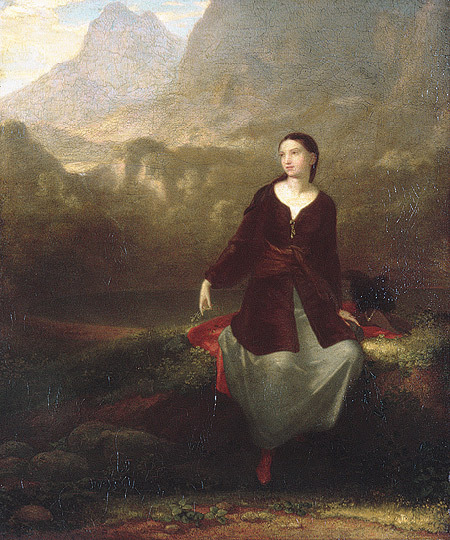
***
Americans often enjoyed having their portraits painted by itinerant painters like Ammi Phillips who is likely the most famous of this era (1812-1848). Most of the art-work from the 18th and early 19th century is "anonymous." They also sold landscape paintings and other things.
Ammi Phillips (April 24, 1788 – July 11, 1865) was an early New England itinerant folk artist who specialized in portraits. Most American painting until the 1850s was "naive" or "unschooled," but Phillips is today regarded as one of the most important artists of his era.
Ammi Phillips, "Girl in a Red Dress" was probably painted around 1832

**
The US had its own patriotic/historic paintings:
Thomas Sully, "Passage of the Delaware" (1819)

Sully: "The Capture of Major Andre," 1812

**
George Caitlin (see next message) "Buffalo Harbor," 1825
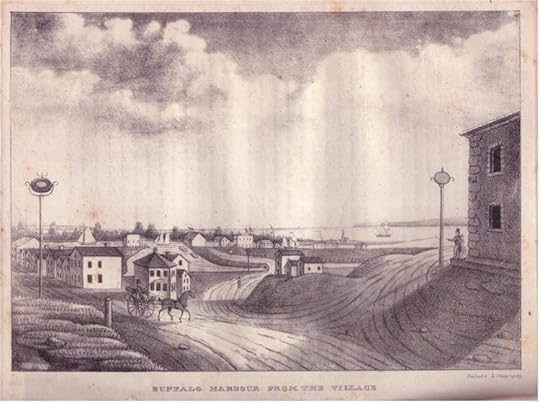
**
Edward Hicks
Hicks, "Peaceable Kingdom," c. 1834 (a classic)
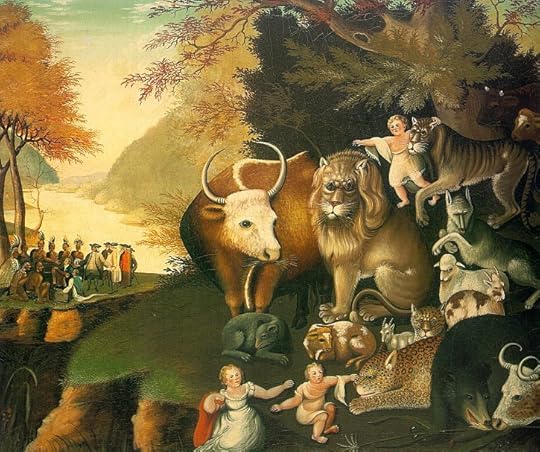
Hicks, "Penn's Treaty," 1847
**
Nathaniel Currier, "Awful conflagration of the steam boat Lexington," 1840
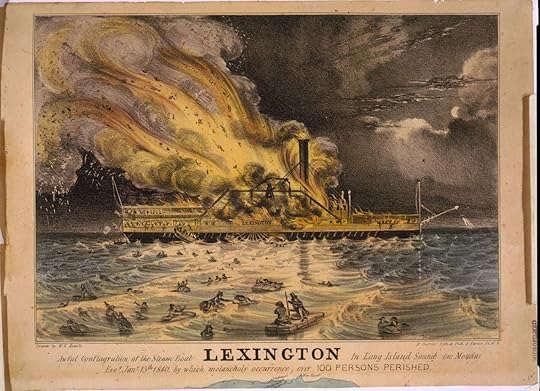
**
Asher Brown Durand, "Signing of the Declaration of Independence," 1823
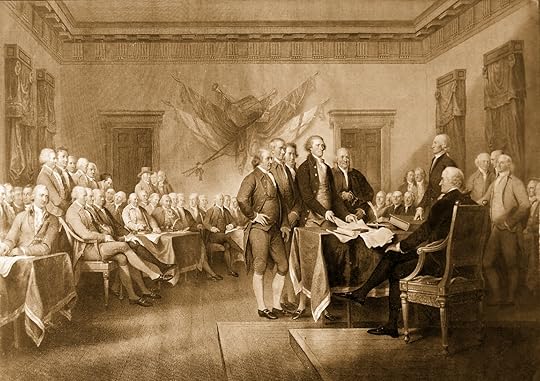
Durand, "View near Rutland, Vermont," 1837
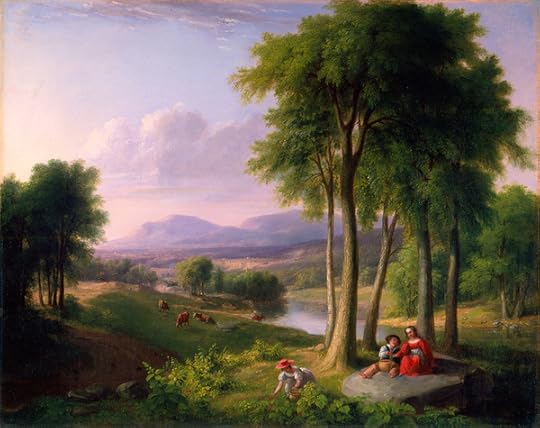
*************
And commissioned patriotic portraits:
Thomas Sully, "Thomas Jefferson" c. 1821
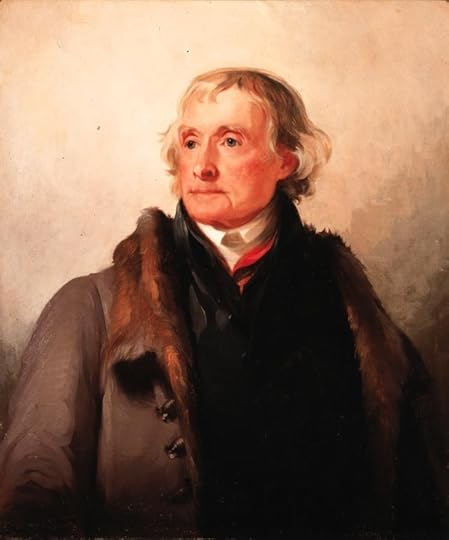
Chester Harding. "Daniel_Boone" c. 1820
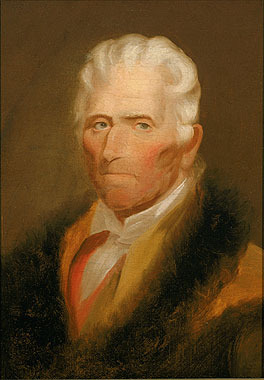
Sully, "John Quincy Adams" c

John Trumbull: "Surrender of Cornwallis" 1820
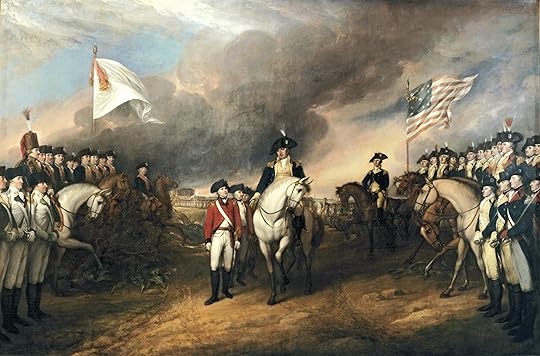
Thomas Sully:
"Portrait of Andrew Jackson," 1824 ( used for the United States twenty-dollar bill from 1928 onward)

***********
Then came Gilbert Stuart - painter of presidents:
Stuart, "George Washington" - 1825

Stuart, "John Adams" 1823
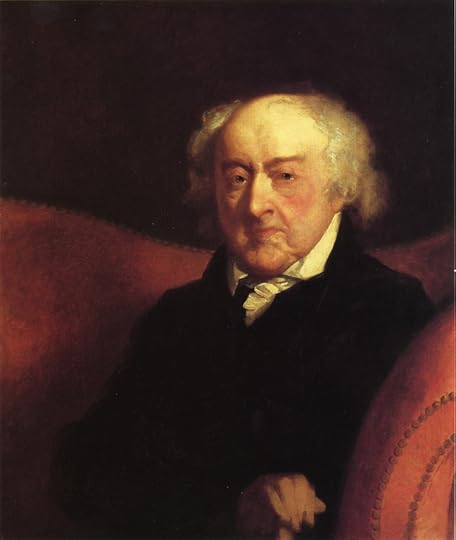
Stuart, "James Madison," c. 1821
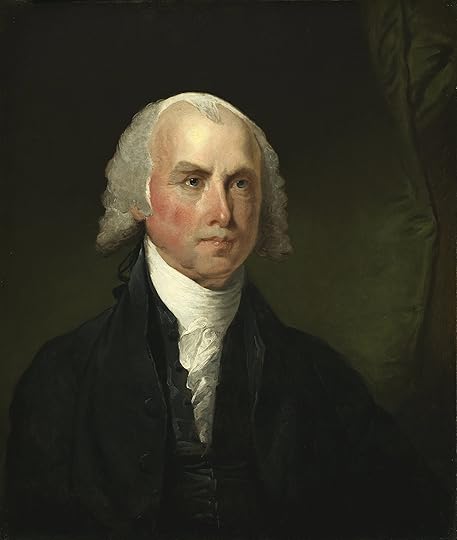
Stuart, "Anna Payne Cutts," (sister of First Lady Dolley Madison,) 1804" - c. 1821-26

Stuart, "James Monroe" c. 1820-1822
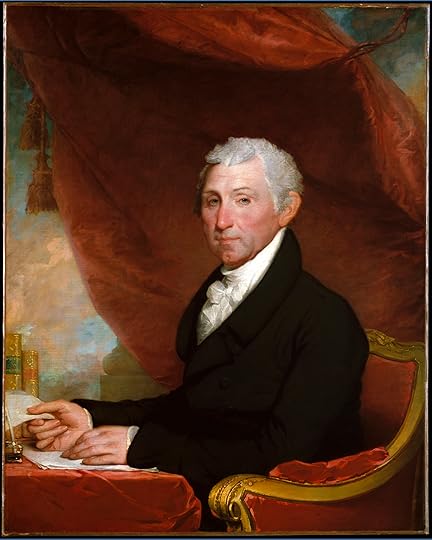
Stuart, "John Quincy Adams," c. 1818
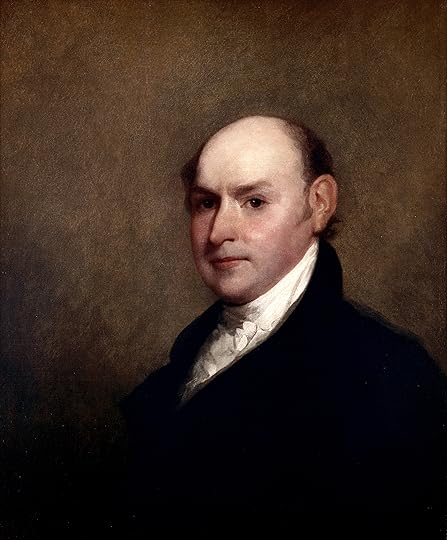
Stuart, "Daniel Webster," c. 1825
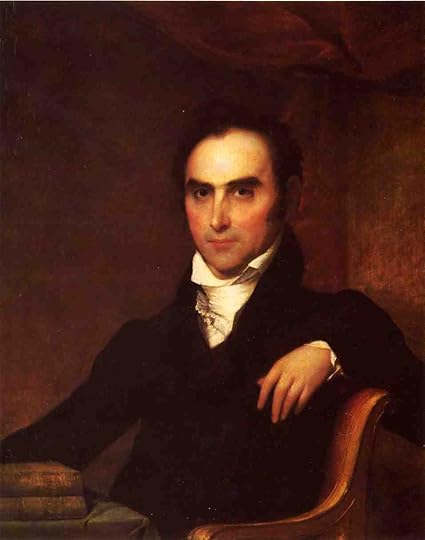
Stuart, "Alexander Hamilton" - c. 1832
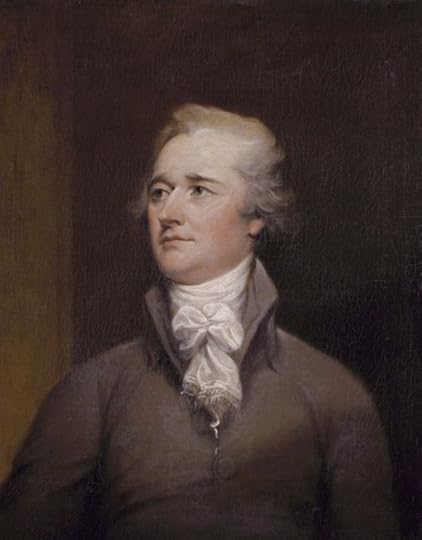
**********
 But the most important development in the US art scene at the time was The Hudson School of art which was developed under the leadership of Thomas Cole. These painters emphasized realistic American landscapes and wilderness.
But the most important development in the US art scene at the time was The Hudson School of art which was developed under the leadership of Thomas Cole. These painters emphasized realistic American landscapes and wilderness. Thomas Doughty, "Ruins in a Landscape," 1828

Doughty, "In the Catskills," 1836,
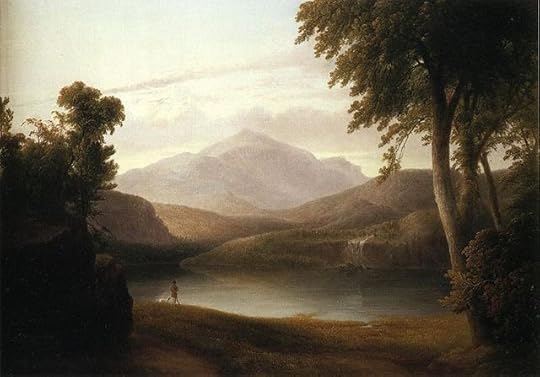
Thomas Cole "The_Oxbow," 1836
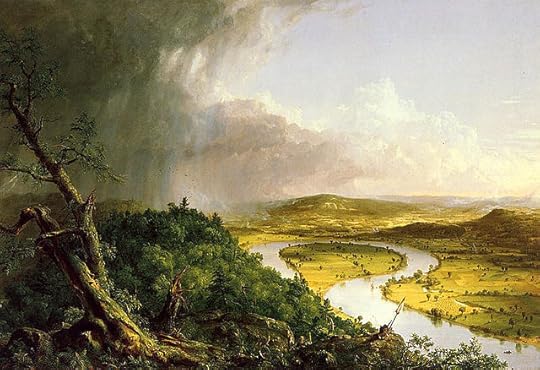
Robert Walter Weir, "The Entrance To a Wood," 1836
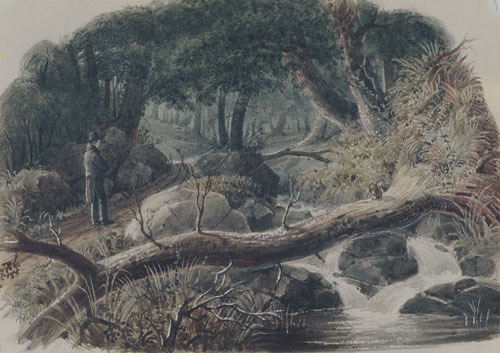
Asher Brown Durand "The Indian's Vespers" 1847

***********
And then there were the naturalists:
John Audubon
"Washington Sea Eagle," c. 1836-1839
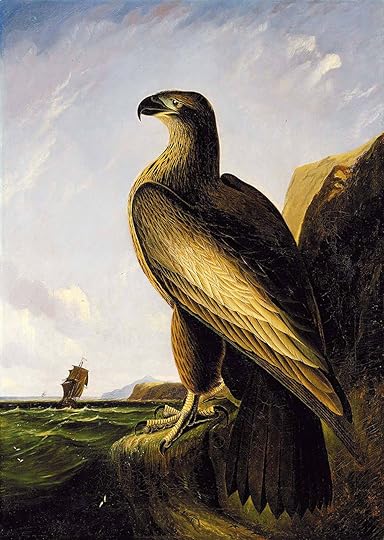
Audubon, "Virginian Partridge" Plate 76 - Birds of America
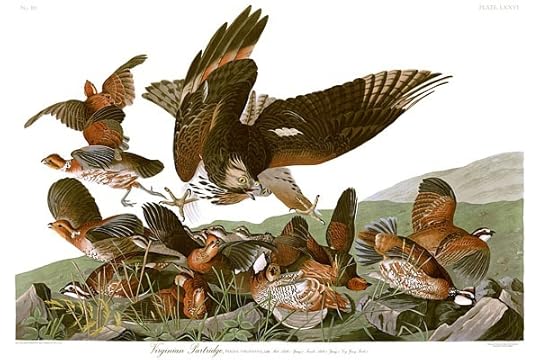
Thomas Cole, "Home in the Woods" 1836
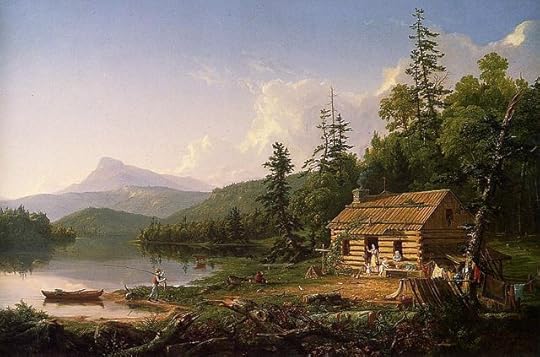
***********
Other - George Catlin tried to paint the Native Americans before they were extinct:
Catlin, "Chief Four Bears" 1833
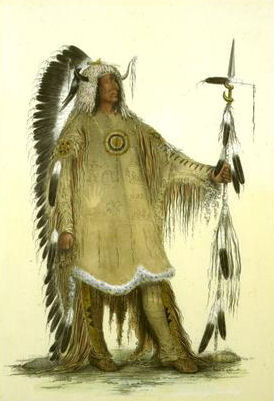
Catlin, "Painting a Chief," 1841
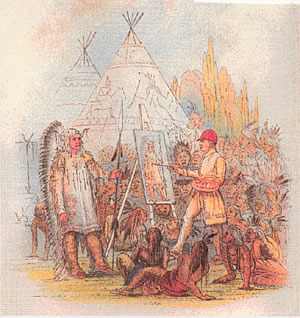
Catlin, "Ball Players" (date unknown)
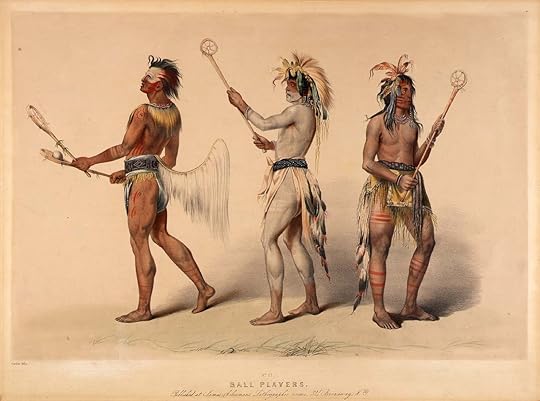
***********
And finally - from What God Hath Wrought:
Professor Morse seemed an unlikely inventor. He was not a scientist, engineer, or mathematician but a professor of fine arts at New York University. A distinguished portrait painter, he had aspired to nurture American nationhood and shape public taste through painting historical panoramas and founding the National Academy of Design. (p. 692)
Morse: "Jonas Platt" - 1828
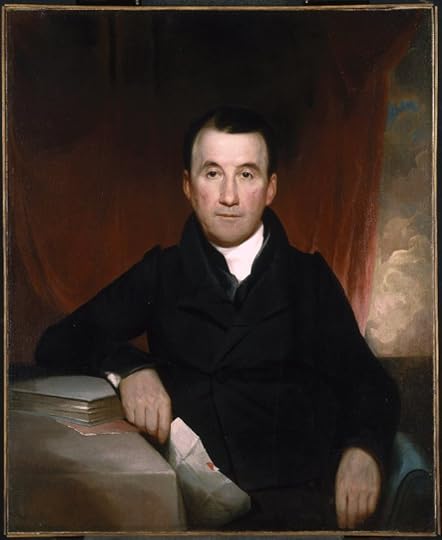
"Gallery of the Louvre," 1831-1833
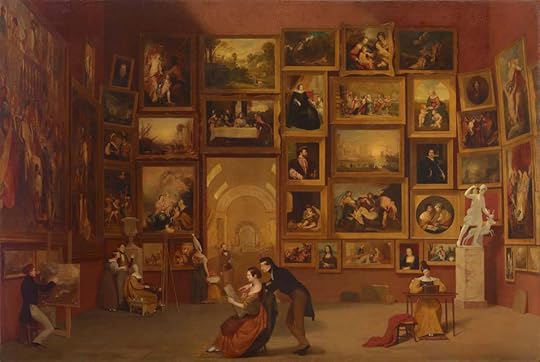
"The Chapel of the Virgin at Subiaco," 1830

****
What all this led to in American art was the real flowering of the Hudson River School and "sublime landscape" paintings like a few of the above and just a few years later, like this:
Albert Bierstadt, "Lander's Peak," 1863
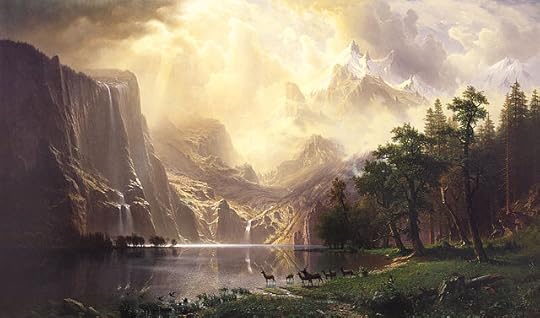
and this:
Asher Brown Durand, "The Catskills," 1857,
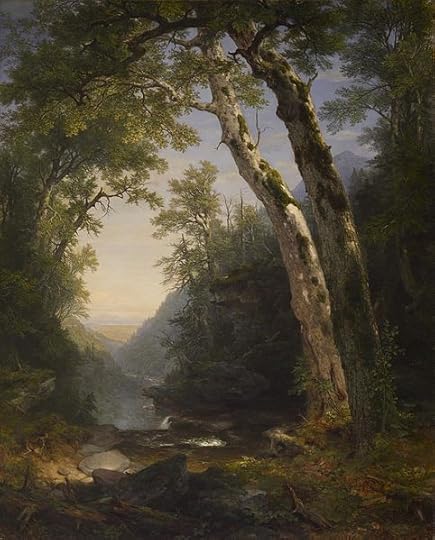
 Added from discussion on Chapter Nine -
Added from discussion on Chapter Nine - This tendency to think life can be better, is part of the American psyche as a whole. I think it's at least partly why we worry about what we did wrong.
See Kevin Starr, particularly Americans and the California Dream, 1850-1915 for more.

 Kevin Starr
Kevin Starr
 Moved from Chapter 17
Moved from Chapter 17I'd like to add a link to a series of sci-fi books that are specifically about this time. Admittedly, they do have a form of magic, but the author has done his research This was my first introduction to William Henry Harrison other than as statistic and slogan (Tippecanoe and Tyler too!) As the author notes his version of Harrison is very different from the original. Actually I've been told that this is actually a fictionalization of Joseph Smith's life.
ALTERNATE HISTORY!!

 Orson Scott Card
Orson Scott CardSeries Tales of Alvin Maker
Books mentioned in this topic
Seventh Son (other topics)Americans and the California Dream, 1850-1915 (other topics)
The Comanche Empire (other topics)
Retrospect of Western Travel (other topics)
Illustrations of Political Economy: Selected Tales (other topics)
More...
Authors mentioned in this topic
Orson Scott Card (other topics)Kevin Starr (other topics)
Pekka Hämäläinen (other topics)
Harriet Martineau (other topics)
Daniel Walker Howe (other topics)




This is the glossary for What God Hath Wrought. This is not a non spoiler thread so any urls and/or expansive discussion can take place here regarding this book. Additionally, this is the spot to add that additional information that may contain spoilers or any helpful urls, links, etc.
This thread is not to be used for self promotion.